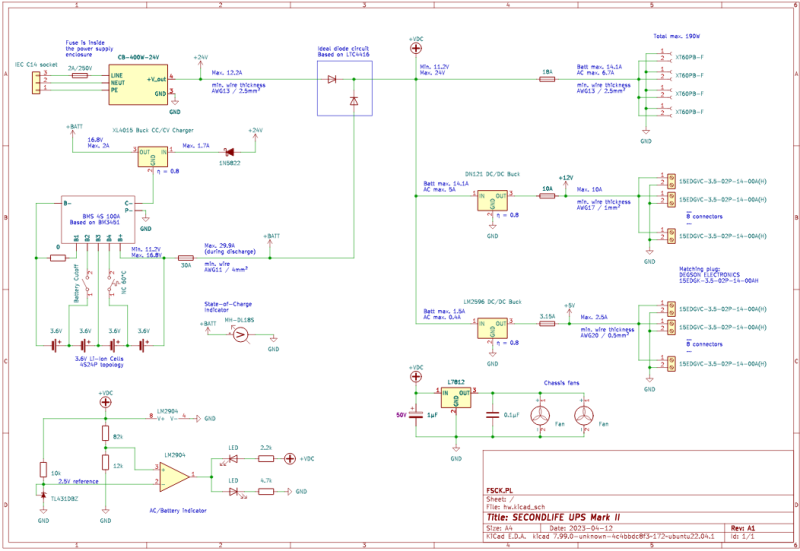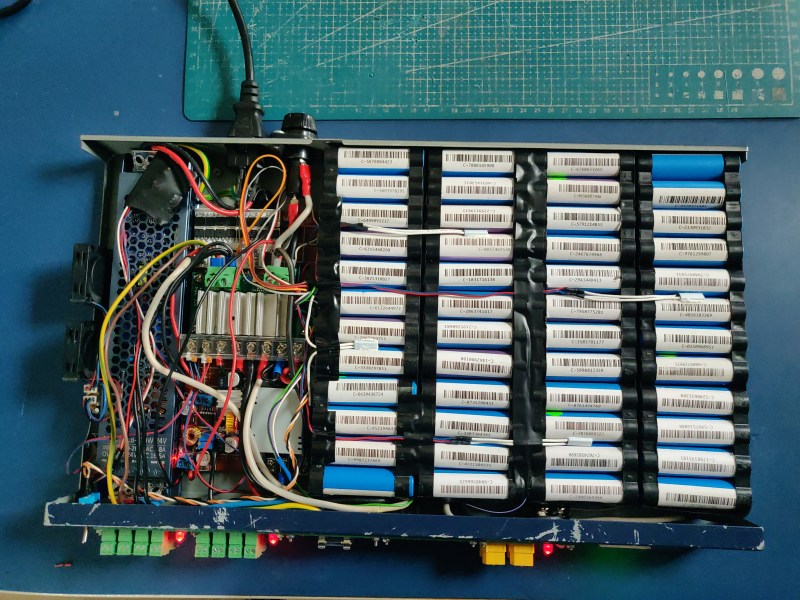When you have a whole stack of devices and appliances that all have an AC to DC adapter and which you’d like to put on an uninterruptable power supply (UPS), you could do the obvious thing and get an off-the-shelf UPS with myriad AC outputs. In the case of a 19″ rack this means wrangling a power strip or two and any combination of differently sized AC/DC adapters into the rack, with questionable efficiency and waste heat dumped into the rack. This is where a DC-only UPS like [Maciej Grela]’s Second Life UPS Mark II provides an interesting alternative.
At its core it’s a pretty simple concept: A single 400Watt power supply handles the AC/DC conversion from mains to 24 VDC, which feeds the battery charger as well as the outputs. These outputs include 5 VDC, 12 VDC and Vrail, with the latter being either the output from the PSU, or the battery voltage. In case of AC power failure, an LT4416 dual power path controller handles the switch-over from the PSU output to the internal batteries. In the article, [Maciej] covers how the buck modules for the 12 & 5 VDC rails were sized, along with the conversion of an old rack-mounted network switch into a UPS.
The 18650s for the batteries (in 4S24P configuration) are all refurbished cells for a total of about 600 Wh, depending on the used cells. For the front panel the existing network port cut-outs were reused for pluggable connectors, along with easily accessible fuses for all rails. Although not a project for the faint of heart, and targeting those who enjoy a bit of spot welding battery packs, it could be an interesting project, especially when considering the option of using it with a 24+ VDC off-grid installation and cutting out the usual DC-AC-DC conversion.

(Thanks to [JohnU] for the tip)















I’ve found it easiest to get an automotive 12v lead-acid battery that’s still got some life in it. Easy to get or build a charger for that. Then a simple DC distribution board with fuses or breakers for different loads. Many devices like routers or cable modems run directly from 12v dc, and there are inexpensive DC-DC boards for other required voltages.
I’ve also found used car batteries to be a surprisingly good option where “cheap or free” is the overriding consideration rather than size, weight, or longevity… but in this particular scenario, where the UPS needs to fit in a rack with limited space, this sounds much better – especially thinking back to the lead-acid behemoths I’ve had the misfortune to schlep in and out of server racks over the years.
Hi, please be careful with car batteries at home.
From what I remember, they’re not meant to be used in closed rooms.
I think it’s because of the explosive gas that it may release.
A lead-acid or lead-gel battery is fine, though. It’s sealed and does release gas only in an emergency.
Speaking under correction, of course. That’s merely what I remember so far. I thought I should tell.
Yes, car batteries vent hydrogen gas. Sealed Lead Acid and AGM do not.
I guess that’s why it’s illegal to park a car in a garage then….
SLA and AGM generate the same gas. It just builds up pressure at end of life until the battery bursts or if you’re lucky deforms and bubbles out. I the hydrogen isn’t going to catch fire because it would need a spark to initiate that fire. And it needs to sit around and accumulate which hydrogen doesn’t like to do being lighter than air and smallest atom. It leaks out of balloons faster than helium. And batteries just don’t produce hydrogen fast enough to accumulate from one or two batteries.
Under normal conditions it’s reabsorbed. Sealed just means sealed until the seal fails. And you want that seal to fail easily, peacefully. Tightly sealed batteries are bombs.
I maintain 192v strings of SLAs and it’s always a pain to get dead batteries out when they’re warped and melted together. They don’t burn because of hydrogen gas they burn because they get hot when cells fail shorted and the battery becomes an effectiveshort circuit.
The quantity of gas from one or two batteries is not worth consideration, even near an open flame.
Where it becomes an issue is if you have a massive malfunction of a data center size battery array in a highly sealed room.
I’m sure you all think you are very important but your four or 8 batteries in a closet somewhere do not need venting.
You have a greater risk from that venting bringing in fresh air during a fire then you’d have from hydrogen building up.
Lead-acid batteries can generate gas, but that’s mainly at higher charge/discharge current rates, or when overcharging (eg equalizing). At lower currents, this shouldn’t be significant. But yes, I place it where air can circulate freely. No closing it up in a closet or small room.
> rack with limited space
is the last place I would be stuffing a box of recycles LIION cells
I cringe pretty hard seeing them all stuffed together like that. DO NOT build something like this until AFTER you have fully charged a pack, and then shot it with a nail gun to witness and appreciate it’s full glory. (Nail gun is more effective than actual gun btw)
That’s my problem with these projects. I don’t trust 18650s en masse, especially being used and hand assembled banking. I will not build anything with more than 8. I would love to see these projects focus on LiFEPO cells instead.
Let’s say you have a handful of reputable network devices all running off of the 12v outputs. Is any form of ground isolation necessary? Is there any issue with the ground path sending too much current through a port if using a shielded cable if two devices are using the same output? Should they be using separate buck converters if this is a concern (essentially an isolation transformer)
Dunno if specifically necessary but most if not all Ethernet RJ48 connections / cable-runs / devices don’t need the shield to be connected at either/both end(s).
In fact most normal home routers I’ve seen don’t have shielded ports at all and I’ve installed a few rj48 double sockets where the shield wasn’t connected through (may have been cheap manufacturing).
And I think I’ve read somewhere that some connections >1Gbit/s actually work better / over longer distances if the shield in the cable isn’t continuous but split in distinct pieces with specific lengths and separations between them (something in accordance with the transmission frequency/wavelength?).
In many situations, shields should only be connected at one end of the cable to prevent ground loops. I guess if that wasn’t feasible, you could just cut the shield in the middle of the cable and ground both ends to have a similar effect.
What sucks is that DC to DC conversion isn’t particularly efficient either, and in my home network things are pretty varried 5, 12, 24, 48v even some 9v! I try to replace wallwarts with Poe adapters. Even if the device doesn’t need data. At least I can individually monitor mw and reboot them remotely that way. Switches run on ups of course.
Ethernet magnetics modules are already basically isolation transformers. The shielding isn’t for power/ground safety, it’s for interference rejection.
Tip: There is a drop-in LTspice test jig for the ADI LTC4416 Power Path Controller ready for download on the part’s product page here:
https://www.analog.com/en/products/ltc4416.html#product-tools
Assuming you already have the free and non-crippled LTspice simulator already installed, just download the LTC4416_TA01.asc schematic from the page link above to a folder anywhere and double-click the file to load it in LTspice. Then run the simulation (click Simulation > Run) and in the schematic pane click the IN and OUT labels to see the circuit operate in the plot pane. Finally, before you close the simulation you might want to click File > Save Plot Settings.
I loved this. Just what I was searching for. I am looking to do a full dc powered everything in my garage.
No matter the alternatives and variations we may come up with to accomplish this UPS task, the author’s approach and learnings is their beneficial journey. Author has compiled a nice collection of things they have looked at, played with and projects completed (https://pop.fsck.pl/index.html ) . Just to produce the shared documentation is a great discipline. This sort of keener would be a great asset on many a technical team.